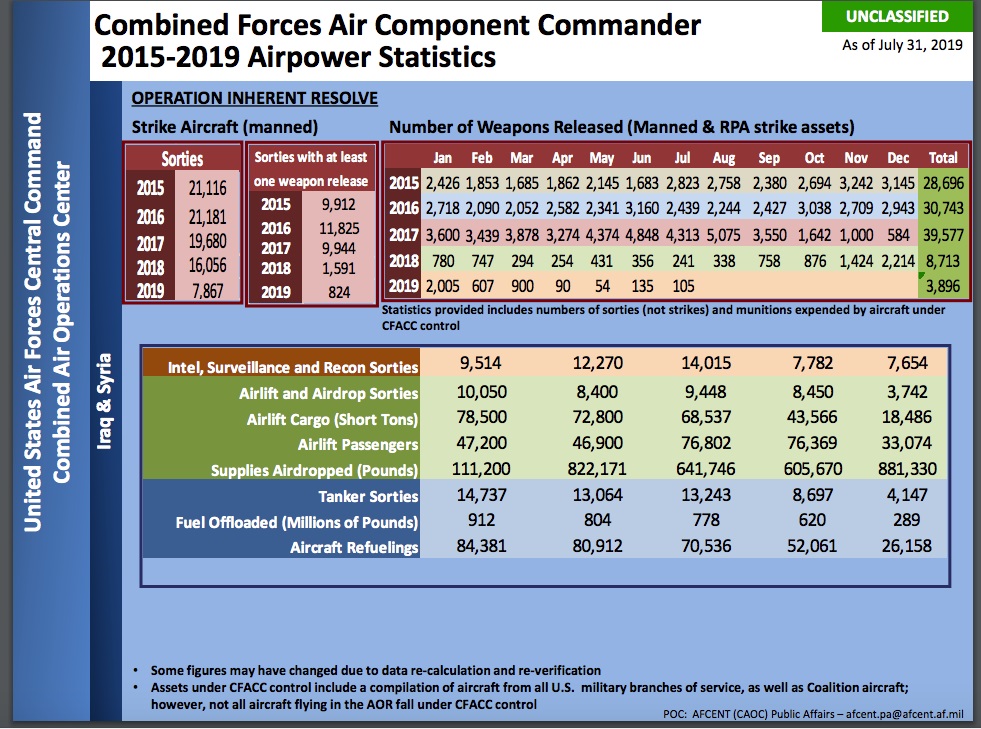
Statistics recently released by the US Air Force and reported in Air Force Magazine confirm that the activities of the Islamic State have been increasing in Iraq and Syria—just as other sources, including Kurdish officials and the Pentagon’s Lead Inspector General, have previously stated, like reported by kurdistan24.net.
According to the US Air Forces Central Command, Combined Air Operations Center, airstrikes by the US and other Coalition members going back to January 2015, reached their lowest number two months ago—in May. But after that, airstrikes more than doubled, rising from 54 in May to 135 in June and dipping somewhat to 105 in July.
Other statistics also suggest a resurgence of the terrorist group. They include the number of intelligence, surveillance and reconnaissance sorties conducted in support of combat operations against the Islamic State.
From January through July of 2019, there were 7,654 such sorties. They are, thus, on track to surpass, by a significant number, the 7,782 sorties conducted in all of 2018.
Similarly aircraft refuelings and tanker sorties, if continued at their current rate, will match last year’s totals, while airdropped supplies in the first seven months of 2019 have already surpassed 2018 levels.
A recently released report from the office of the Lead Inspector General helps explain these statistics. “Despite losing its territorial ‘caliphate,’ the Islamic State in Iraq and Syria (ISIS) solidified its insurgent capabilities in Iraq and was resurging in Syria this quarter,” the report, covering the three-month period from April to June, stated.
“ISIS’s reconstitution and transformation into an insurgency in Syria this quarter appears to follow a pattern established in Iraq, where USCENTCOM said ISIS has formed a capable insurgent operation based in several Iraqi provinces north and west of Baghdad,” it added.
Kurdish officials have long issued similar warnings about the reemergence of the terrorist organization. Last month, as Prime Minister Masrour Barzani met Brig. Gen. Gregory Kreuder, Chief of the US Office of Security Cooperation-Iraq, he warned of the “rising activity from ISIS sleeper cells as the security gap in Iraq remains, particularly in the disputed territories.”
Similarly, Kamal Ibrahim, Kurdistan Democratic Party (KDP) representative in the disputed town of Qara Tepe, west of Kirkuk, recently cautioned, “ISIS has reorganized its militants, increasing their attacks on Iraqi Security Forces and civilians as well.”
Yet, US President Donald Trump campaigned in 2016 on a promise to end the post 9/11 wars, and he would like to believe that the Islamic State has been defeated and that, at least in Syria, US troops can come home.
Indeed, Trump is the second US president to try to end, or at least significantly reduce, the US military presence in this area. Barack Obama tried to do the same, ending Operation Iraqi Freedom (OIF) in 2011 and withdrawing US forces from Iraq—only to return them three years later to fight the Islamic State.
In fact, Trump would like to go further than Obama and withdraw a significant number of US troops from Afghanistan as well.
Trump’s impatience with the ongoing wars is, perhaps, understandable in light of the George W. Bush administration’s failure to define and explain its objectives in the post 9/11 wars, even as Bush and his senior advisors anticipated they would finish those conflicts during their own term in office.
Indeed, it is hard now to recollect the Bush administration’s triumphalism, once it recovered from the shock of the 9/11 attacks. Operation Enduring Freedom (OEF), the war in Afghanistan, began on October 7, 2001. Already in December, Bush believed he had won there and began to prepare for war in Iraq.
OIF began on March 20, 2003. In May, Bush believed he had basically won in Iraq too. He then began to prepare for another conflict, recalling the top commanders from Iraq, so they could prepare for it, as Lt. Gen. Daniel Bolger (US Army, retired), relates in his memoirs, Why We Lost.
Of course, no more wars followed. However, in November 2003, the Bush administration adopted a new diplomatic initiative with a far-reaching objective: transform the Middle East through democracy.
Following his re-election, in January 2005, Bush went even further, proclaiming, “It is the policy of the United States to seek and support the growth of democratic movements and institutions in every nation and culture, with the ultimate goal of ending tyranny in the world.”
Peggy Noonan, a speechwriter and Special Assistant to Ronald Reagan, and later a Wall Street Journal columnist, suggested that Bush had embraced an unattainable goal. “Tyranny is a very bad thing and quite wicked, but one doesn’t expect we’re going to eradicate it any time soon,” she wrote. “This is not heaven, it’s earth.”
The Bush administration was slow to recognize the challenges in Iraq. Secretary of Defense Donald Rumsfeld derided the insurgents as “dead-enders” and prohibited analysts from describing the violence as an “insurgency”—which implied that it was a serious challenge. Only after Rumsfeld left office in 2006, did the administration really begin to tackle the violence in Iraq. In 2007, Gen. David Petraeus assumed command there, and “the surge” followed.
But in the process, four years were lost, while a key question was never clearly addressed: who are we fighting and why?
Those questions lie behind Trump’s impatience with these long wars and his desire to declare enemies, like the Islamic State, defeated, when the statistics, as well as commanders in the field, say that is not so.
Since 9/11, the US has done one thing: fight “radical Islam” or some equally ill-defined version of that term. It does more of that or it does less of it. But what it does not do is rethink basic assumptions; ask why aren’t we doing a better job of combatting this; and explore the possibility of a fundamentally different approach.


